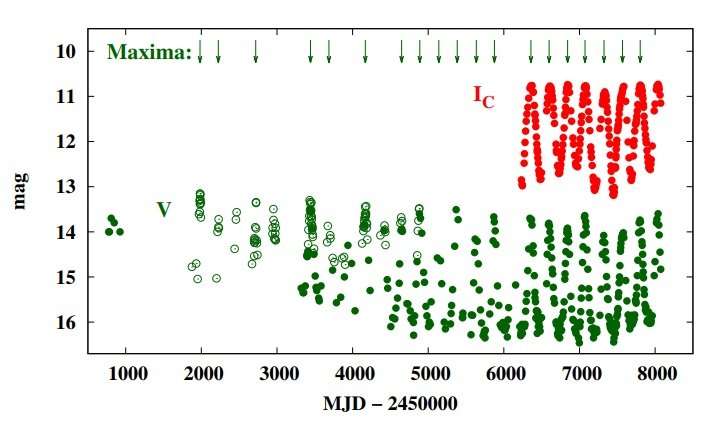January 4, 2019 report
Hen 3-160 is a symbiotic binary with Mira variable star, study suggests

A new study conducted by a team of astronomers from Poland and South Africa provides more insights into the nature of Hen 3-160, a symbiotic binary system in the southern Milky Way. The research, presented in a paper published December 22 on arXiv.org, proposes that this object is a symbiotic binary containing a Mira variable star.
It is assumed that symbiotic binaries showcase dramatic, episodic changes in the spectra of their light because one star of pair is a very hot, small star while the other is a cool giant. In general, such systems are essential for researchers studying various aspects of stellar evolution.
Astronomers divide symbiotic stars (SySt) into two main classes: S-type and D-type. Most known SySts are of S-type, which have near-infrared spectra generally dominated by the cool star's photosphere, and are indistinguishable from ordinary late-type giants. D-type symbiotic stars exhibit additional emission attributed to thick circumstellar dust shells. SySts of this class experience large amplitude variations due to the presence of Mira variables (red giants with pulsation periods longer than 100 days, and amplitudes greater than one magnitude in infrared and 2.5 magnitude at visual wavelengths) and other long-period variable stars.
Although Hen 3-160 (other designations: SS73 9, WRAY 15-208, Schwartz 1 and 2MASS 08245314-512832) was first spotted in the 1960s, no detailed studies of this binary have been conducted, and very little is known about the parameters of its components. Thus, a group of astronomers led by Cezary Gałan of Nicolaus Copernicus Astronomical Center of the Polish Academy of Sciences in Warsaw, Poland, decided to analyze data from spectroscopic and photometric observations of Hen 3-160 collected during a timespan of over two decades.
Gałan's team used optical spectra obtained with SpUpNIC spectrograph on the 1.9-m Radcliffe telescope in Sutherland, South Africa, and photometric optical data acquired with a 35-cm Meade RCX400 telescope in Klein Karoo Observatory, near Sutherland. Analysis of this data sheds new light on the nature of Hen 3-160.
"In this work, we present new observations collected over two decades which enabled us to reveal its very interesting nature," the astronomers wrote in the paper.
The main conclusion from this study is that the giant in the Hen 3-160 system is a Mira variable pulsating with 242.5-day period. Moreover, it is the first known symbiotic Mira that is simultaneously the S-process enhanced star of MS spectral type.
In particular, the researchers found that the large-amplitude periodic variations observed in the optical V and IC-band light curves with the pulse period of over 100 days, which were correlated with changes in other bands as well in the spectra, indicate that the cool component is a Mira star. Furthermore, the presence of comparably strong ZrO and TiO bands are indicative of the MS spectral type for this object, and place it among the S stars, proving that it is enhanced in the S-process elements.
The astronomers also estimated the distance of the Hen 3-160 system. They found that the binary is located some 30,600 light years away from the Earth, about 4,200 light years above the disk of the Milky Way galaxy. They added that galactic coordinates of Hen 3-160, together with relatively high proper motions, make it a galactic extended thick disc object.
More information: C. Galan et al. Hen 3-160 - the first symbiotic binary with Mira variable S star. arXiv:1812.09535 [astro-ph.SR]. arxiv.org/abs/1812.09535
© 2019 Science X Network




















